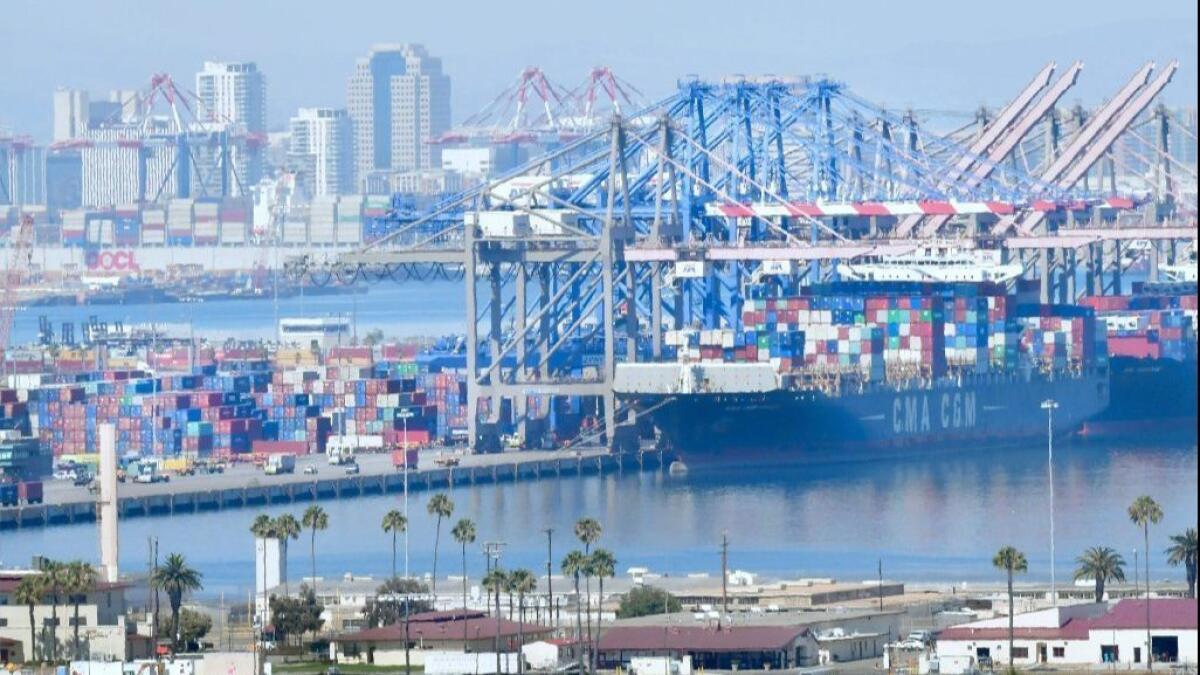U.S. proposes tariffs on $200 billion more in Chinese imports

- Share via
President Trump escalated his trade war with China on Tuesday, identifying an additional $200 billion in Chinese products that he intends to hit with import tariffs.
The move makes good on the president’s threat to respond to China’s retaliation for the initial U.S. tariffs on $34 billion in Chinese goods, which went into effect Friday and would eventually place nearly half of all Chinese imports under tariffs.
Administration officials said the tariff fight is aimed at forcing China to stop stealing American intellectual property and to abandon policies that effectively force U.S. companies to surrender their trade secrets in return for access to the Chinese market.
“These practices are an existential threat to America’s most critical comparative advantage and the future of our economy,” said Robert Lighthizer, the president’s chief trade negotiator.
Trump’s latest action will hit consumer products, such as televisions, clothing, bedsheets and air conditioners, which were spared from the first import levies Friday. But the new tariffs will not be imposed until the end of a two-month public comment period.
“This is where a painful situation gets more painful,” said Phil Levy, a former White House economist in the George W. Bush administration.
Early reaction to the president’s action was unfavorable. “Tonight’s announcement appears reckless and is not a targeted approach,” said Sen. Orrin Hatch, chairman of the Senate Finance Committee.
Beijing has vowed to respond in kind to any U.S. trade action. But China only bought about $135 billion in U.S. goods last year, meaning it will run out of American products to tax before it matches Trump’s latest move.
Chinese officials are expected to retaliate in other ways, hitting U.S. firms in China with unplanned inspections, delays in approving financial transactions and other administrative headaches.
“The Trump administration is gambling that by wielding such a big club, it will force China to back down,” said Edward Alden, a senior fellow at the Council on Foreign Relations. “That is almost certainly a serious miscalculation. China is far more likely just to find other ways to hit back in kind.
The president has repeatedly described his resort to tariffs, which are paid by American importers, as a lever to extract negotiating concessions from U.S. trading partners.
A few rounds of talks with Chinese leaders earlier this year made little progress, however, and no plans for additional meetings have been made public.
U.S. officials say they remain willing to bargain. But a senior administration official who briefed reporters Tuesday on the condition that he not be identified added: “We do intend to keep the pressure on them.”
The Trump administration said it cracked down on China trade practices involving intellectual property and technology that cost U.S. companies an estimated $50 billion annually.
Trump authorized an initial $50 billion in tariffs, including the $34 billion that took effect Friday, to match those losses.
China’s retaliation to those measures was “without any international legal basis or justification,” Lighthizer said Tuesday.
The senior administration official blamed China for the intensifying commercial conflict between two nations that account for roughly 40% of the global economy.
“They were the ones who started everything by hurting us,” the official said.
Tuesday’s announcement included a 205-page public notice and list of the individual products that could be hit by the new 10% tariffs.
Lighthizer’s office plans four days of public hearings on the trade actions starting Aug. 20.
“Trump’s escalation of trade hostilities makes it increasingly difficult to envision an exit path from an all-out trade war,” said Eswar Prasad, former head of the International Monetary Fund’s China division. “This new round of proposed tariffs takes the fight onto yet another level from which it is going to be difficult for either side to make a graceful retreat.”
Beijing, meanwhile, has unveiled measures to help Chinese companies absorb the U.S. trade blows, pledging to funnel money collected from its own import levies to firms and workers tangled in the escalating trade war.
Chinese officials also encouraged businesses to reduce their reliance on U.S. goods, urging them to shift orders for products such as soybeans and automobiles to suppliers in China or countries other than the United States.
“For companies that are severely impacted, we suggest they report to local government departments,” the Commerce Ministry said in a statement Monday.
The ministry released no further details about how it would spread the financial relief or whether the aid would cover the total cost of losses, but analysts said the move suggests China could significantly increase its support for industries that stand to be bled by the commercial battle.
China also seems to be projecting confidence that it can withstand political turmoil, said David Rank, former deputy chief of mission at the U.S. Embassy in Beijing.
“Xi Jinping and the Communist Party do not face midterm elections in November,” Rank said of the Chinese president, who is no longer bound by term limits. “Moreover, they will blame any economic troubles on Trump and the United States.”
Lynch and Paquette write for the Washington Post.
More to Read
Inside the business of entertainment
The Wide Shot brings you news, analysis and insights on everything from streaming wars to production — and what it all means for the future.
You may occasionally receive promotional content from the Los Angeles Times.










